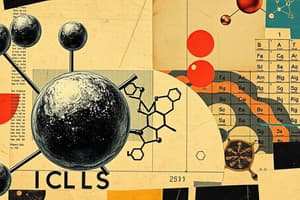Podcast
Questions and Answers
What is the main difference between covalent and ionic bonds?
What is the main difference between covalent and ionic bonds?
- Covalent bonds result in positively charged ions, while ionic bonds result in negatively charged ions
- Covalent bonds are weaker than ionic bonds
- Covalent bonds form between atoms of the same element, while ionic bonds form between different elements
- Covalent bonds involve sharing electrons, while ionic bonds involve transferring electrons (correct)
When an atom gains electrons, what charge does it acquire?
When an atom gains electrons, what charge does it acquire?
- Positive charge
- No charge is acquired
- Neutral charge
- Negative charge (correct)
What is the formula representation for a compound made of atoms A and B?
What is the formula representation for a compound made of atoms A and B?
- $A + B$
- $A - B$
- $A / B$
- $A_x B_y$ (correct)
Which type of bond allows atomic nuclei to be held together in a molecule?
Which type of bond allows atomic nuclei to be held together in a molecule?
What fundamental concept is essential for comprehending the vast world of chemistry?
What fundamental concept is essential for comprehending the vast world of chemistry?
Flashcards are hidden until you start studying
Study Notes
Atomic Structure and Atoms & Molecules in Chemistry
At the heart of chemical processes lie the basic building blocks that make up all matter: atoms and molecules. To fully understand the world of chemistry, it's essential to delve into the intricacies of atomic structure.
Atomic Structure
Atoms are the fundamental units of matter, consisting of a central nucleus and orbiting electrons. The nucleus, which contains protons and neutrons, is an incredibly dense and positively charged region at the center of the atom. The electrons, which are negatively charged, orbit the nucleus in shells or energy levels.
The nucleus itself is composed of two types of particles: protons and neutrons. Protons, with a positive charge of +1, are responsible for an atom's chemical behavior and its position within the periodic table. Neutrons, which have no charge, primarily influence an atom's mass and are responsible for the majority of its weight.
The number of protons in an atom's nucleus, or atomic number (Z), uniquely identifies that specific element. The atomic mass, which is the sum of protons and neutrons, is reported as atomic mass units (amu), with one amu being approximately the mass of a proton or neutron.
Atoms
Atoms of the same element but with different numbers of neutrons are called isotopes. These isotopes have the same atomic number (Z) but differing atomic masses due to their varying numbers of neutrons (N). Neutrons do not affect an atom's chemical behavior, but they do influence its physical properties.
Atoms can also undergo ionization, where they lose or gain electrons, forming ions. If an atom loses one or more electrons, it gains a positive charge, while if it gains one or more electrons, it acquires a negative charge.
Molecules
When two or more atoms bond, they form molecules. In a molecule, atoms share or transfer electrons to form chemical bonds, which can be covalent (sharing electrons) or ionic (transferring electrons). These bonds allow the atomic nuclei to be held together, creating a stable structure with unique physical and chemical properties.
Molecules can be made of only one type of atom (monatomic) or can be formed from two or more different types of atoms (polyatomic). In the latter case, the molecule is called a compound, and its formula is represented as A_x B_y, where A and B are the symbols of the elements, and x and y are the numbers of atoms in the compound.
Understanding atomic structure and the behavior of atoms and molecules is essential for comprehending the vast and diverse world of chemistry. These fundamental concepts pave the way for grasping the complexities of chemical reactions, properties of substances, and the development of innovative materials and processes.
Studying That Suits You
Use AI to generate personalized quizzes and flashcards to suit your learning preferences.




